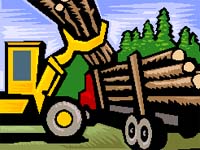|
|
Forestry in the Cedar River Watershed
TOPIC/ISSUE:
The Cedar River municipal Watershed covers 90,546 acres or 141 square miles. Much of the upper watershed is comprised of second growth and old growth forest resources. Balancing the uses of the watershed involve trade-offs between different stakeholders. Historically the watershed has been used to support a timber harvest program, generating revenue for landowners including private timber companies and the City of Seattle. Over the years the City has acquired all but a small portion of the watershed. Although some logging continues today, the primary management objective of the upper watershed is to protect water quality. Other uses of the watershed include using the area as an ecological reserve, educational and research uses. Access to the watershed has been prohibited since 1917, eliminating opportunities for recreational uses such as hiking, skiing, snowmobiling, canoeing and fishing. Timber harvest and the related construction and maintenance of roads in the upper watershed has been perhaps the one issue in management of the watershed that has generated the most public debate in recent years. The issues have included timber harvest methods, the amount of forested area that should be kept in reserve, protection of remaining old growth stands and decommissioning of roads.
BACKGROUND:
The Cedar River Municipal Watershed is entirely undeveloped with the exception of
infrastructure required for the timber harvest program. Over the past 100 years of
timber harvest has left the watershed with only about 16% of the original forest
and over 600 miles of roads. Much of the timber harvest activity occurred after 1910,
it is estimated that 84% of the forest is second growth, with stands less than 80 years old.
The watershed is located in highly productive soil area west of the Cascades. The vegetation type includes Douglas fir, western hemlock and red alder and Pacific silver fir, noble fir, and subalpine fir and mountain hemlock at the upper elevations. Over the past 15 years, annual timber harvest in the Cedar River Municipal Watershed has fluctuated from year to year. In general the number of thousand board feet has declined significantly. The peak harvest was in 1986 with nearly 41,000 thousand board feet harvested, the lowest year reported since the peak year was 1997 with 200 thousand board feet harvested. This decline can be attributed in part to the general decline in the forest industry and in part to municipal acquisition (as of 1997 the City owned all forested land in the basin) of the watershed and the management objective to protect water quality in the basin. As a matter of perspective, timber harvest in the peak year of 1986 throughout King County totaled nearly 400,000 thousand board feet. Since 1994 all timber harvested in the watershed has been owned by the City. The revenue generated by the City for timber harvest has fluctuated from a high of just over $1 million in 1994 to a low of around $50,000 in 1996. These revenues have been dedicated to a land and habitat acquisition program in the basin. Affected acreage has also varied from year-to-year but as generally affected a small proportion of the second growth stands and all old growth stands have been in reserve.
The public debate of how the municipally owned forest resources should be managed has most recently been evidenced in the draft Habitat Conservation Plan. The draft plan called for placing 64% of the watershed in an ecological reserve; based on public comment the final HCP protected 100% of the watershed in reserve. The draft HCP called for using the revenue from timber harvest to fund elements of the HCP, again public sentiment preferred that all commercial harvest be eliminated and funding for the HCP be obtained from other sources, even water rates.
STAKEHOLDER PERSPECTIVES.
As evidenced above the amount of revenue generated from timber harvest is somewhat inconsequential. During the review period of the draft HCP, one might be surprised at the level of interest in eliminating commercial harvest entirely. A portion of the interest in this issue can surely be tied to the public desire to protect the water quality of their drinking water supply, however maybe other considerations or sentiments were being expressed. Perhaps the public was expressing their views on the value of keeping or returning the area to a more pristine condition for the sake of ecological reasons as part of a key component of a larger ecosystem or for the intrinsic value of the trees in and of themselves. The following lists the potential stakeholders in landuse of the watershed:
? Seattle Public Utilities.
? Protection of water quality to minimize treatment costs of water
? Resource steward for the public
? Restore ecological value
? Generate revenue for the Utility
? General Public
? Maintain High water quality, safe drinking water supply
? Ensure watershed is managed for future generations
? Willing to pay higher water rates to eliminate commercial harvest
? Intrinsic value of the watershed
? Timber Companies
? Generate revenue
? Less incentive to manage harvest for long-term sustainability due to public ownership
? Construct roads to minimize harvest costs
? Recreation Groups & Users
? Due to congestion and population growth at surrounding recreation areas, the
Undeveloped watershed provides potentially high recreational value (no tragedy of the commons)
Over the past several decades balancing water resource uses between human use activities and protecting
the environment has become more challenging in many watersheds in particular watersheds that have faced tremendous
growth such as the Puget Sound Region. With the recent listing of several anadromous fish species under the endangered
species act, balancing of resources needs in the watershed has become more challenging by not only including different
stakeholders but also requirements to meet federal statutes. |
